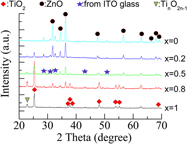Crossref Citations
This article has been cited by the following publications. This list is generated based on data provided by
Crossref.
Fang, Mei
Voit, Wolfgang
Wu, Yan
Belova, Lyubov
and
Rao, K.V.
2013.
In-situ preparation of metal oxide thin films by inkjet printing acetates solutions.
MRS Proceedings,
Vol. 1547,
Issue. ,
p.
13.
Liu, Xiaonao
Tarn, Tzyh-Jong
Huang, Fenfen
and
Fan, Jie
2015.
Recent advances in inkjet printing synthesis of functional metal oxides.
Particuology,
Vol. 19,
Issue. ,
p.
1.
Mariani, Paolo
Vesce, Luigi
and
Di Carlo, Aldo
2015.
The role of printing techniques for large-area dye sensitized solar cells.
Semiconductor Science and Technology,
Vol. 30,
Issue. 10,
p.
104003.
Fang, Mei
Liu, Fang
Li, Tianli
Zhang, Wenchao
Xia, Huayan
Rao, K V
and
Belova, Lyubov
2019.
Inkjet printing Ag-TiO2 thin films with suppressed photoluminescence.
Semiconductor Science and Technology,
Vol. 34,
Issue. 10,
p.
105027.
Winarski, David
and
Selim, Farida
2019.
Sol-Gel Method - Design and Synthesis of New Materials with Interesting Physical, Chemical and Biological Properties.
Fang, Mei
Li, Tianli
Zhang, Sangjian
Rao, K. V.
and
Belova, Lyubov
2020.
Design and tailoring of inks for inkjet patterning of metal oxides.
Royal Society Open Science,
Vol. 7,
Issue. 4,
p.
200242.
Babar, Falak
Mehmood, Umer
Asghar, Hafza
Mehdi, M. Hassan
Khan, Anwar Ul Haq
Khalid, Hamza
Huda, Noor ul
and
Fatima, Zaira
2020.
Nanostructured photoanode materials and their deposition methods for efficient and economical third generation dye-sensitized solar cells: A comprehensive review.
Renewable and Sustainable Energy Reviews,
Vol. 129,
Issue. ,
p.
109919.
Liu, Han-Yin
Hou, Fu-Yuan
and
Chu, Hung-Sheng
2020.
Mg0.35Zn0.65O/Al/ZnO Photodetectors With Capability of Identifying Ultraviolet-A/Ultraviolet-B.
IEEE Transactions on Electron Devices,
Vol. 67,
Issue. 7,
p.
2812.
Hussain, Syed Mohd
Sadullah, Md
Marwaha, Shikha
and
Ghosh, Kunal
2023.
Aerosol-assisted chemical vapour deposition of titanium dioxide thin films on silicon and implementation of a heterojunction diode.
Bulletin of Materials Science,
Vol. 46,
Issue. 3,
